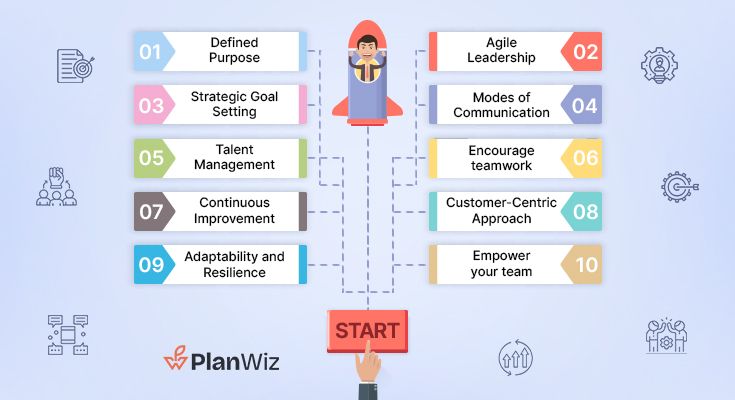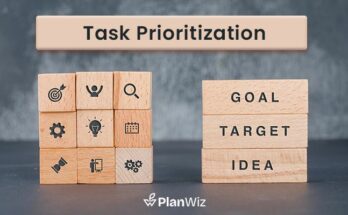Feeling overloaded by a barrage of tasks and to-dos? Take a deep breath and relax, because I’ve got your back! In this handy guide, we’re plunging into 10 Innovative organizational strategies that’ll whip your life into shape and supercharge your productivity. Whether you’re grappling with time management or your workspace resembles tornado aftermath, these tips will help you conquer disorder and flourish in both your personal and professional life.
Organizational strategies are crucial for businesses to operate efficiently and effectively. Whether you’re a small startup or a large corporation, implementing the right organizational strategies can make a significant difference in productivity and success. From streamlining workflows to improving communication, these strategies encompass a wide range of practices that are essential for achieving business objectives.
Table of Contents:
- Defined Purpose and Objectives
- Agile Leadership
- Strategic Goal Setting
- Effective Modes of Communication
- Talent Management and Development
- Encourage teamwork
- Continuous Improvement
- Customer-Centric Approach
- Adaptability and Resilience
- Empower your team
- Final Thoughts
1. Defined Purpose And Objectives:
Organizational strategies are like the roadmaps that guide businesses and institutions. They’re super important because they help these groups reach their big goals and work smarter, not harder. Think of it like this: imagine you’re on a treasure hunt. You need a map to find the treasure, right? Well, organizational strategies are like that map. They show you the best way to get where you want to go.
Integrating technologies like Planwiz Planner can enhance the effectiveness of organizational strategies by providing structured planning and coordination.
The essence of organizational strategies lies in their ability to align resources, people, and processes toward a common vision. They serve as blueprints, guiding decision-making and resource allocation across various levels of the organization. From market penetration to diversification, these strategies encompass a wide array of tactics tailored to capitalize on strengths and mitigate weaknesses.
In today’s fast-paced world, organizational strategies must be agile and responsive to change. They need to incorporate flexibility and adaptability to navigate uncertainties and capitalize on emerging opportunities. By embracing a proactive mindset and fostering a culture of continuous improvement, organizations can stay resilient and thrive in turbulent times.
In the ever-evolving business landscape, adaptable organizational strategies are paramount. They function as dynamic roadmaps, aligning resources and people towards collective objectives. Embracing flexibility and fostering innovation allows organizations to navigate uncertainties and capitalize on emerging opportunities. Continuous evaluation ensures ongoing relevance, keeping the strategy agile and responsive to changing environments.
2. Agile Leadership:

Agile leadership a crucial component of organizational strategic planning is like having a captain who’s quick to adapt and guides the team through tough times together. They listen to everyone’s ideas and change plans as needed to keep up with what customers want. This creates a space where everyone feels encouraged to share new ideas and make things better. With agile leaders, we can handle whatever challenges come our way while staying flexible and responsive
Being a great leader is like being the captain of a ship. It’s all about trusting your crew and letting them take charge. Instead of breathing down their necks, you give them the freedom to own their tasks, and you encourage them to take risks. This way, you build up their confidence and resilience. And when things get tough, they’re ready to adapt and face challenges head-on. It’s about creating a culture where everyone feels empowered to make decisions, even in uncertain waters, because together, you’re steering towards success.
In our ever-changing world, being adaptable is crucial for leaders. It helps organizations stay ahead, predict market shifts, and capitalize on new opportunities. Through clear communication, empathy, and leading by example, these leaders inspire teams to reach their full potential, fostering innovation and driving organizational strategies forward.
Adaptability is crucial for leaders. It involves swift responses, customer understanding, and flexible planning. Good leaders foster open communication and lead by example, turning challenges into opportunities for improvement. With innovative thinking, they propel their organization forward, ensuring growth and relevance.
3. Strategic Goal Setting:
Setting strategic goals is super important for any company aiming to do well. These goals act like a map, showing the way for the company to reach its goals and stay in line with its big vision. To get started with this, it’s really important to look closely at what the company is good at, what it could be better at, what chances there are, and what could get in the way. Once leaders know all this stuff, they can figure out what needs fixing and where they can make the most of opportunities. That sets a strong base for setting those big strategic goals.
Once the analysis is complete, the next step is to define clear and measurable objectives, using daily planner templates. These objectives should be specific, achievable, relevant, and time-bound (SMART). For example, instead of setting a vague goal like “increase revenue,” a SMART goal would be “increase quarterly revenue by 15% within the next fiscal year.” This specificity helps provide clarity and focus, enabling teams to work towards tangible outcomes effectively.
With SMART goals in place, teams focus on precise targets, fostering alignment across the organization. Clear objectives ensure everyone understands their role, driving progress toward overarching vision. Organizational strategies guide efforts, ensuring everyone pulls in the same direction for success.
4. Effective Modes Of Communication:

Effective communication is key to successful teamwork. Face-to-face talks rock because they give instant feedback and clear up any confusion. Plus, you can catch those non-verbal cues! Whether it’s a team pow-wow, brainstorming, or a chat one-on-one, talking in person builds trust and understanding among teammates.
Electronic communication facilitates rapid information exchange among dispersed teams, enhancing collaboration and productivity. Yet, over-reliance on these tools may result in information overload and misinterpretations due to the absence of non-verbal cues. Balancing efficiency with mindful communication is key to maximizing the benefits of electronic platforms
Deferred communication, like project management software and shared documents, is crucial in organizational strategies. These platforms enable team members to work at their own pace, regardless of time zone differences, enhancing productivity. They allow individuals to contribute ideas, provide updates, and collaborate on projects without needing real-time interaction. This flexibility promotes efficiency and effective teamwork within the organization.
5. Talent Management And Development:
Talent management and development are super important for any organization to succeed. It’s not just about hiring the right people; it’s about helping them get better at what they do. By focusing on talent management, businesses make sure their employees stay excited, motivated, and ready to tackle new challenges.
One essential organizational strategy is to invest in continuous learning and development programs. By offering training opportunities, workshops, and resources, organizations empower their employees to upskill and stay relevant in a rapidly changing market. This not only enhances individual performance but also strengthens the overall capabilities of the workforce, contributing to the organization’s competitive outline.
Encouraging mentorship and coaching among employees boosts growth. Pairing veterans with newcomers shares knowledge and support. This speeds up learning and preserves institutional wisdom. It creates a supportive environment for all to thrive. Overall, it’s a win-win for the team and the company.
Recognizing and rewarding talent is key. With fair evaluation and incentives, we keep our team motivated and shape our culture. It’s not just about money; a pat on the back or a chance to grow means a lot too. Let’s make sure everyone feels valued and sees opportunities ahead.
6. Encourage Teamwork:

Teamwork is crucial for any organization’s success. By working together, team members can achieve more than they could alone. When people collaborate, they share their ideas and skills, which leads to better problem-solving and innovation. It’s like putting together pieces of a puzzle – each person brings something unique to the table, and when they combine their efforts, they can accomplish great things.
Encouraging teamwork also helps improve communication within the organization. When team members collaborate, they share information more openly and build trust with each other. This transparency makes it easier to work together smoothly and creates a positive work environment where everyone feels valued.
Teamwork, an integral part of organizational strategic planning also fosters a sense of accountability among team members. When people work together on a project, they feel responsible for its success. This shared responsibility motivates them to do their best and ensures that everyone pulls their weight.
Encouraging teamwork boosts happiness and job satisfaction at work. When people feel like they’re part of a team, they’re more excited about their job. Working together creates a sense of friendship and togetherness, making work more enjoyable and productive for everyone.
7. Continuous Improvement:
Continuous improvement is key to effective organizational strategies, emphasizing incremental enhancements to products, services, and processes. It fosters a culture of learning and adaptation, encouraging all members to contribute ideas. By consistently seeking better methods, companies can outpace competitors and meet evolving customer demands.
One essential strategy for continuous improvement is fostering open communication within the organization, facilitated by the integration of a daily planner app. Employees should feel empowered to share their thoughts and suggestions without fear of judgment. This can lead to valuable insights and innovative ideas that drive positive change. Additionally, regular feedback loops, whether through surveys, town hall meetings, or one-on-one discussions, provide valuable information on areas that require improvement.
Setting clear goals and benchmarks is another crucial aspect of continuous improvement. By defining what success looks like and regularly measuring progress, organizations can identify areas of strength and areas needing attention. These goals should be specific, measurable, achievable, relevant, and time-bound (SMART), providing a roadmap for improvement efforts.
Using technology and automation helps to simplify processes, eliminating inefficiencies for continuous improvement. From new software tools to robotics and AI, tech advancements optimize operations. Staying updated on emerging tech and using it wisely helps organizations grow sustainably and stay competitive.
8. Customer-Centric Approach:

In today’s competitive business landscape, adopting a customer-centric approach is more crucial than ever. This strategy revolves around placing the needs and preferences of customers at the forefront of every decision and action within an organization. By prioritizing the customer experience, businesses can build stronger relationships, enhance satisfaction levels, and pave the way for long-term success.
One essential organizational strategy is to thoroughly understand your customers. This involves conducting market research, gathering feedback, and analyzing data to gain insights into their preferences, behaviors, and pain points. With a deep understanding of your target audience, you can tailor your products, services, and marketing efforts to meet their needs and expectations better.
Another vital aspect of a customer-centric approach is effective communication. Open and transparent communication channels allow businesses to listen to customer feedback, address concerns promptly, and keep them informed about relevant updates and offerings. Whether it’s through social media, email, or customer service channels, maintaining clear and consistent communication helps build trust and loyalty.
Making sure employees focus on making customers happy is super important. By training them well, creating a culture where customers come first, and rewarding good interactions, companies can make sure every employee is dedicated to giving great service. When employees feel like they matter and are trusted, they’ll work harder to make customers happy.
9. Adaptability And Resilience:
Organizations need to be flexible and tough. Time management tips suggest that they must adjust quickly to new situations and bounce back stronger from setbacks. This means they have to adapt fast to changes like economic shifts, new technology, or unexpected crises like pandemics. Adaptability is about changing fast, while resilience is about recovering and becoming even stronger after tough times.
A key way for organizations to boost adaptability and resilience is by implementing organizational strategies that promote a culture of innovation and ongoing learning. This means encouraging employees to be creative, try out new ideas, and embrace change. By doing this, they develop a mindset that can adapt to anything. Additionally, offering training and development opportunities ensures that employees keep up with what’s happening in the industry and learn new skills to tackle any challenges that come their way.
Another important strategy is to focus on good communication and teamwork within the organization. When there are open lines of communication, it’s easier for ideas, feedback, and information to flow between teams. This helps teams adapt quickly when priorities change or unexpected problems arise. By creating an environment where everyone feels comfortable sharing their thoughts and ideas, organizations can use the collective brainpower of their employees to solve problems and come up with new ideas.
Investing in good risk management is key to organizational resilience. By anticipating and planning for potential risks, businesses can reduce their impact. Having backup plans and scenario analysis helps companies react swiftly to adversity. This ensures business continuity and long-term sustainability.
10. Empower Your Team:

Empowering your team means giving them tools, resources, and freedom to innovate. Clear goals and expectations help everyone stay focused and motivated. This fosters collaboration and boosts productivity. When individuals see their contributions aligning with the bigger picture outlined in the organizational strategic planning, they feel more engaged. In short, empowerment drives success through clarity and support.
Encourage your team to speak up and share thoughts openly. Make a safe space where ideas and concerns are welcomed. By listening and acting on feedback, show that every opinion matters. This builds trust, boosts morale, and makes everyone feel responsible. In short, open communication breeds teamwork and ownership.
Lead by showing empathy, integrity, and resilience. Encourage your team to do the same. Inspire them to reach their full potential. Create an environment where everyone feels valued and empowered. Empowering your team means fostering motivation and contribution.
Final Thoughts:
Businesses must embrace these ten key strategies for success in today’s fast-paced world. From setting clear goals to giving teams more power, these steps are vital. When companies focus on working smart, communicating well, and being ready to change, they can overcome obstacles, spark new ideas, and reach their goals in the long run.
By following these strategies, not only do we get more done, but we also create a great atmosphere at work where everyone feels appreciated and capable. As our business grows and we deal with new stuff, sticking to these strategies will keep us moving forward and staying ahead of the game.




